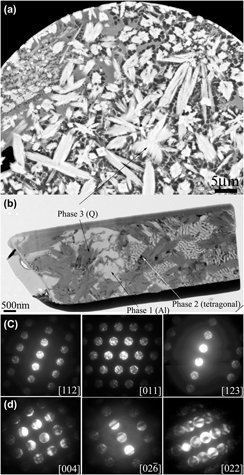Crossref Citations
This article has been cited by the following publications. This list is generated based on data provided by
Crossref.
Li, X. P.
Yan, M.
Ji, G.
Qian, M.
and
Zou, Jianxin
2013.
Applied Pressure on Altering the Nano‐Crystallization Behavior of Al86Ni6Y4.5Co2La1.5 Metallic Glass Powder during Spark Plasma Sintering and Its Effect on Powder Consolidation.
Journal of Nanomaterials,
Vol. 2013,
Issue. 1,
Li, X.P.
Kang, C.W.
Huang, H.
and
Sercombe, T.B.
2014.
The role of a low-energy–density re-scan in fabricating crack-free Al85Ni5Y6Co2Fe2 bulk metallic glass composites via selective laser melting.
Materials & Design,
Vol. 63,
Issue. ,
p.
407.
Khun, N. W.
Li, R. T.
and
Khor, K. A.
2015.
Mechanical and Tribological Properties of Spark Plasma–Sintered Titanium Composites Filled with Different Al-Cr-Fe Quasicrystal Contents.
Tribology Transactions,
Vol. 58,
Issue. 5,
p.
859.
Ye, Z.
Zhang, F.
Sun, Y.
Nguyen, M. C.
Zhou, S. H.
Zhou, L.
Meng, F.
Ott, R. T.
Park, E.
Besser, M. F.
Kramer, M. J.
Ding, Z. J.
Mendelev, M. I.
Wang, C. Z.
Napolitano, R. E.
and
Ho, K. M.
2017.
Structural hierarchy as a key to complex phase selection in Al-Sm.
Physical Review Materials,
Vol. 1,
Issue. 5,
Babilas, R.
Łoński, W.
Młynarek, K.
Bajorek, A.
and
Radoń, A.
2020.
Relationship Between the Thermodynamic Parameters, Structure, and Anticorrosion Properties of Al-Zr-Ni-Fe-Y Alloys.
Metallurgical and Materials Transactions A,
Vol. 51,
Issue. 8,
p.
4215.
Pashangeh, Shima
Alizadeh, Morteza
and
Amini, Rasool
2022.
Structural and corrosion behavior investigation of novel nano-quasicrystalline Al-Cr-Fe reinforced Al-matrix composites produced by ARB process.
Journal of Alloys and Compounds,
Vol. 890,
Issue. ,
p.
161774.
Młynarek-Żak, Katarzyna
Wierzbicka-Miernik, Anna
Kądziołka-Gaweł, Mariola
Czeppe, Tomasz
Radoń, Adrian
and
Babilas, Rafał
2022.
Electrochemical characterization of rapidly solidified Al-(Cr,Cu,Ni,Y,Zr)-Fe alloys.
Electrochimica Acta,
Vol. 409,
Issue. ,
p.
139836.
Młynarek-Żak, Katarzyna
Dhiman, Indu
Matus, Krzysztof
Kądziołka-Gaweł, Mariola
Łoński, Wojciech
Radoń, Adrian
Czeppe, Tomasz
and
Babilas, Rafał
2023.
Structural characterization of newly-developed Al79Ni5Fe5Y11 and Al79Ni11Fe5Y5 alloys with amorphous matrixes.
Scientific Reports,
Vol. 13,
Issue. 1,
Wang, Qi
Zhang, Suode
Cui, Jingping
Pan, Shaopeng
Emori, Wilfred
and
Wang, Jianqiang
2024.
Clarifying the alloying effects of La and Ce on the pitting corrosion behaviour of Al-based metallic glasses.
Corrosion Science,
Vol. 230,
Issue. ,
p.
111925.
